12 Dishes To Avoid Ordering At An Irish Pub
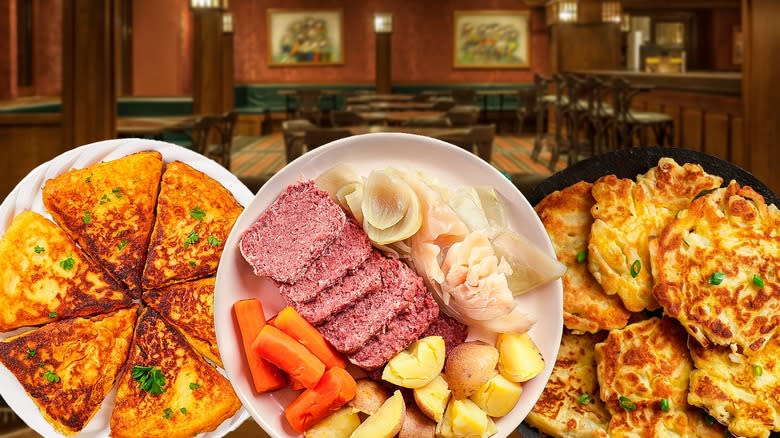
Let's face it, when St. Patrick's Day is around the corner, many of us like to exaggerate our Irish heritage. And why not? The Irish are generally known for their friendliness, their love of potatoes -- possibly the most delicious and versatile food out there, in our (and Samwise Gamgee's) humble opinion -- and, of course, their luck. But if you can't actually trace your ancestry to Blarney Castle or even a great-great-granny who told tales of a family banshee, you'd probably still enjoy visiting an Irish pub for dinner.
But there's a fine line between real, traditional Irish food and the Irish-American variety... though both still tend to showcase potatoes. If you're craving some homestyle comfort, don't just assume that corned beef, canned Irish stew, or a big bowl of mashed spuds are your only options. Oh, and when joining in on the St. Patrick's Day festivities, you might want to think twice before ordering that round of green beers. Read on to find out why, if anything, you should be celebrating with a pint of blue beer, as we explore the dishes you should avoid ordering at an Irish pub.
Read more: Restaurant Foods That Always Taste Better Than What You Make At Home
American-Based Irish Cocktails
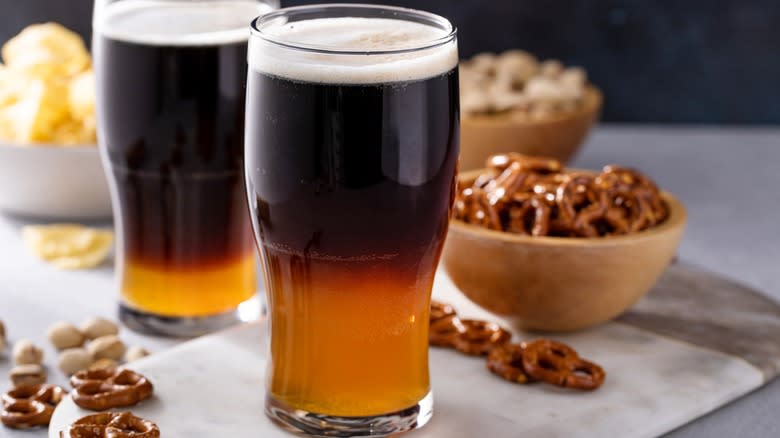
While it might be a little more acceptable to order these in an American Irish-style pub rather than anywhere in Ireland, you should still think twice before requesting certain popular drinks. For example, the controversial Irish car bomb references violence that occurred during the Troubles (aka one of the bloodiest eras in Northern Ireland and the Republic of Ireland's history), and it isn't something you want to raise a toast to, no matter how tasty you think this libation is. Renamed the Dublin drop and the Irish slammer in more recent years, the drink — in which a half pint of Guinness gets the boilermaker treatment with a shot glass of half Jameson Irish Whiskey and half Baileys Irish Cream dropped into it — is still considered an unfortunately glib political statement. So maybe skip it, even if it's offered on the menu. Besides, all three of those ingredients are arguably better on their own.
The other politically skewed bevvy to avoid is the black and tan, a combination of dark and light lagers layered in a pint glass. While not as obviously offensive as the Irish car bomb, this two-ingredient drink will likely bring up negative associations. Named for the sartorial choices (a dark jacket and khaki trousers) of the English military in the Irish War of Independence, a black and tan layers dark stout, such as Guinness, on top of a pale ale like Harp or Bass. Still want one? Ask for a half & half to be a respectful international citizen.
Anything Green For St. Patrick's Day

The same as the Irish car bomb cocktail and other Americanized offerings, anything dyed green for St. Patrick's Day is kind of a big no-no in Irish culture. Green beer isn't even Irish, you might be surprised to learn. Introduced as early as 1914 in the Bronx, the party hit its stride in the 1950s. Traditionally, St. Patrick's Day is a religious celebration in Ireland, rather than one focusing on overindulging in beer and kissing strangers.
Ireland's patron saint, Patrick is celebrated in many ways. The shamrock, which you'll see pretty much everywhere on March 17th, takes the idea of father, son, and holy ghost to its numerological conclusion by making the plant a stand-in for Christianity's Holy Trinity. While St. Patrick brought this notion to the Emerald Isle in the 400s A.D., we eventually caught up stateside, albeit in a less religious way. Ireland has also embraced the modern love for him and goes all out for the big day, even eschewing blue (the original color that signified both St. Patrick and Ireland itself) for all the shades of green seen today.
While Ireland might embrace all that green beer for tourism's sake (and who can blame them?), the green beer served stateside is usually subpar at best. Order something tasty instead — like Murphy's, Harp Lager, Smithwick's Red Ale, or Sullivan's — and revel in your good taste.
Beef Stew
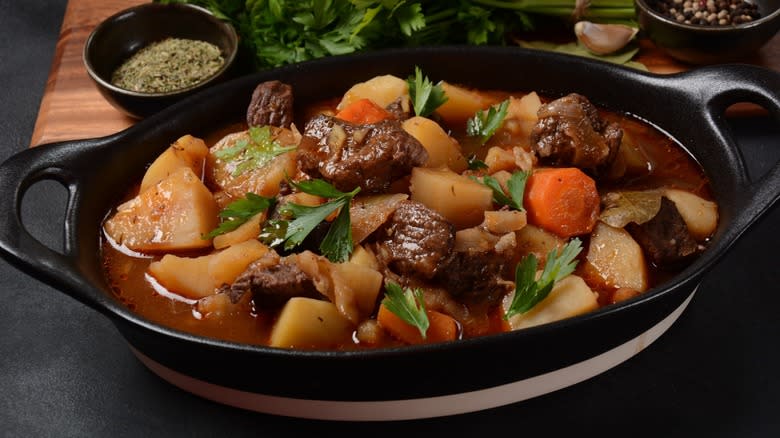
The difference between beef stew and Irish stew comes down to ingredients, as well as the method of preparation. These two popular options may be close in taste, but here's why a traditional Irish stew is the better order at a pub over the beef stew that might be on the menu.
To begin, beef stew is — as you may have guessed — made with beef. As for Irish stew? It's going to be lamb (or mutton), if it's authentic. Beef has never really been big in Ireland, except as dairy, while sheep and pork have always been the go-to protein sources. Instead, beef was brought over with the English, meaning that beef stew is more of an English dish, compared to a traditional Irish lamb stew. Another big difference is the use of roux, a mixture of cooked flour and fat, as a way to thicken up a watery stew. A beef-based stew usually depends on the addition of roux, whereas Irish stew uses that perennial favorite mashed potatoes to give even more body to your meaty mouthful.
Finally, more modern Irish stews will add veggies that might have been unknown to the Irish, even half a century ago. Where the original Irish stew contained carrots and onions, your local pub might add color with red peppers, peas, or even kale.
Boxty
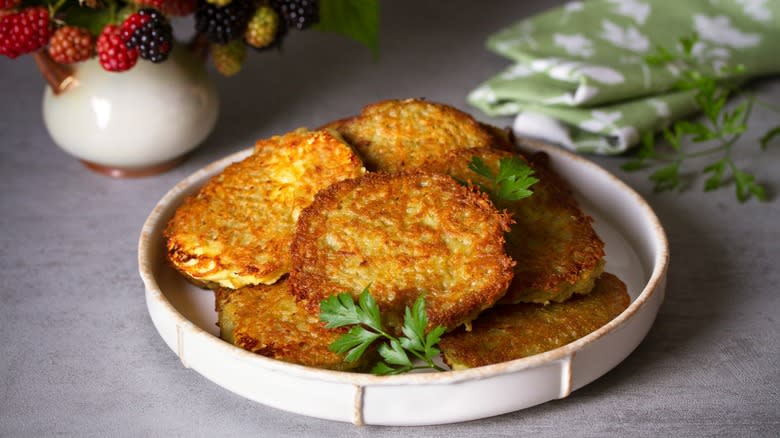
Unless you've gone to an Irish pub with the intention of ordering every potato item on the menu (listen, we've all been there), you might want to rethink ordering the boxty. Similar to farls (potato bread), boxty is a widespread dish that makes use of potatoes for a satiating side that goes with everything or can even be relied on to fill your belly on its own. Typically eaten as a breakfast food, like in a full Irish breakfast, these carb-heavy stunners are made with raw grated potatoes, buttermilk, flour, baking powder, and just enough mashed potatoes to hold everything together. They're not quite bread, not quite a potato pancake, and they're made to get you through a long day in the field, rather than dinner and a movie.
But wait... there's one caveat here: Boxty is so popular and, let's be honest, so absolutely delicious that loads of restaurants have come up with interesting ways to upgrade it from a simple potato dish to something spectacular that's worth ordering. Irish pubs are taking this humble food and stuffing it with everything under the sun, from goat cheese to salmon, and from chicken to mushrooms. Ordering a hybrid dish like that will let you try a beloved taste of an Irish classic without getting massively overstuffed.
Corned Beef And Cabbage
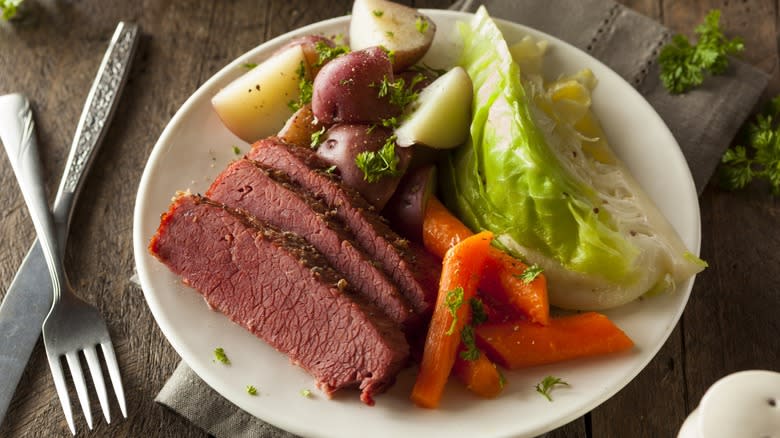
Corned beef and cabbage might be one of the best-known Irish meals out there, right? Except that, it's not Irish — not truly, anyway. Corned beef became a St. Patrick's Day staple with Irish Americans but has never really been all that popular back home. Historically, Ireland's diet relied far more heavily on pork farming, instead using cows for dairy or fieldwork. As previously mentioned, it wasn't until the English invaded that cows became more prevalent. But even then, it generally wasn't the Irish who were eating it; rather, salting and selling what became known as corned beef to the English and French Navies became a way for Irish farmers to make much-needed money in the 16th and 17th centuries. The original version of corned beef was also much more heavily salted; it was food preserved for long sea voyages, not for a delicious, homey dinner.
Irish immigrants in America could generally afford to eat better than they'd been able to under British rule at home; coupled with the fact that they settled in the same areas as Jewish immigrants, it was only a matter of time before these new Americans rediscovered corned beef. All that is to say, the corned beef we think of as a traditional St. Patrick's Day treat is much closer to the Jewish brisket-based version with cabbage added, rather than the version served to sailors centuries prior. We know how delicious corned beef is, but we feel that if you're dining in an Irish pub worth its salt, go for something more authentic.
Cottage Pie
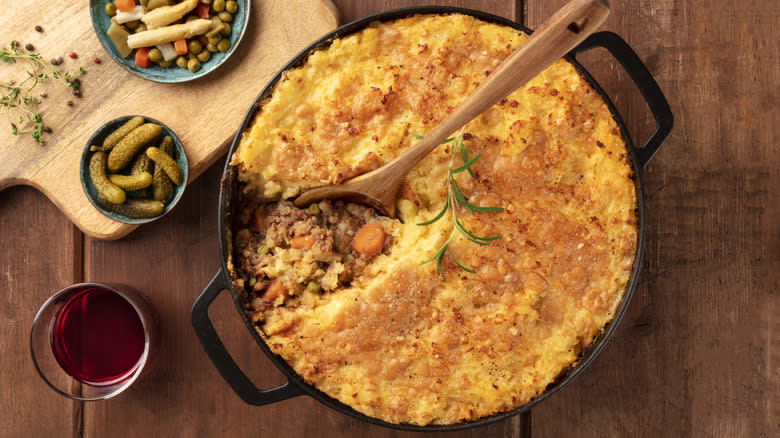
To start, let's clear up what we mean when we talk about cottage pie vs. shepherd's pie. In North America, we're pretty familiar with shepherd's pie as a mixture of minced beef and some chopped veg, topped with a layer of mashed potatoes. But in the UK and Ireland, that's considered a cottage pie, whereas a shepherd's pie is made with minced lamb or occasionally mutton. Mind blown? Just keep in mind that a shepherd herds sheep, and it's easy to remember which is which.
As for calling the beef-filled version a cottage pie, the name most likely came from the shabby dwellings occupied by the lower Irish Catholic class after the British took over. Made from leftovers and topped with inexpensive potatoes, cottage pies were pretty ubiquitous among the poor. Historically speaking, it is possible that those humble pies were made with mutton, as beef was still scarce and reserved for the wealthy, making it more likely that a cow-based cottage pie is a British dish, not an Irish one.
If you're looking for something with real Irish flavor (but still has a lovely layer of those crave-worthy potatoes), try out a traditional Irish shepherd's pie instead. Ireland knows lamb, and this version of shepherd's pie with silky gravy, tender meat, loads of fluffy potatoes, and delicate seasonings might just be your new favorite meal. But if you're lamb-avoidant, it's understandable — lots of people are. It's okay if you opt for the beefier version.
Crisp Sandwiches
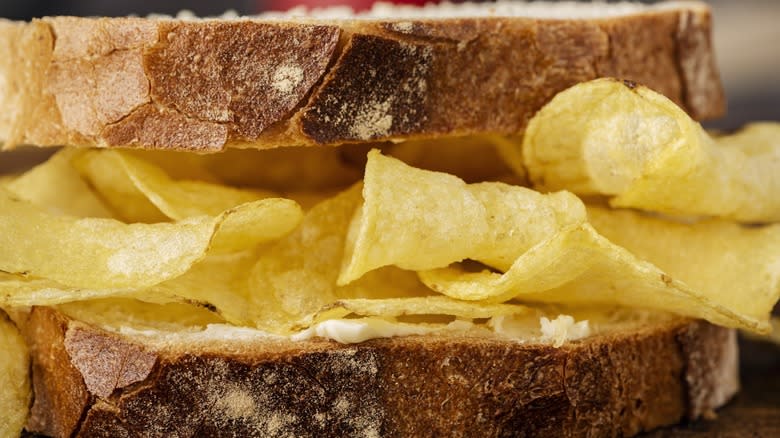
Okay, this one might seem laughable, but if you've tried it, you know just how delectable it can be. Thick slices of fresh bread, slathered with Irish butter (some of the best in the world, honestly), crisp sandwiches are filled with crunchy and salty potato chips. We don't see the problem, here. However, if you're thinking about ordering one at an Irish pub, you might as well just flush that tenner down the loo. If you can get your mitts on the required ingredients, you're better off making them at home, for both affordability and sheer quantity.
This delight reportedly came from an overworked Irish housewife with a load of hungry kids. In the 1960s, Noreen O'Neill apparently had a brilliant idea to fill up 18 kids on a budget. Taking what she had on hand — bread, butter, and crisps — she devised a plan that not only fed her kids but also became a beloved Irish snack for the decades to come. If you've never had a crisp sandwich, don't knock it until you've tried it. The combination of fluffy bread, creamy butter, and crunchy, savory chips just can't be beaten. In the UK and Ireland, cheese and onion crisps are a favorite, but stateside, we don't really have anything comparable unless you have a truly comprehensive international grocer in your neighborhood. That just means you might have to experiment until you find a tasty combo that gives you the foodie goosebumps.
Dublin Coddle
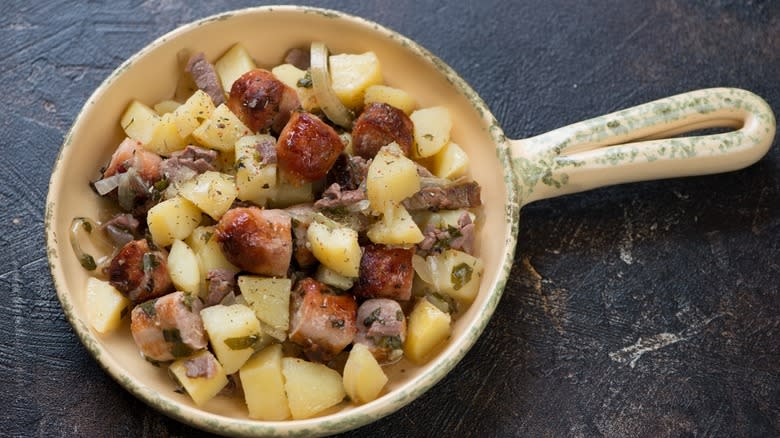
Coddle (or Dublin coddle) is a fairly straightforward dish containing, primarily, a combination of hearty leftovers. Made from a base of parboiled sausages or bacon rashers, adding whatever you happen to have on hand — grains, vegetables, potatoes, and some seasonings (mostly salt, pepper, and parsley) — this dish is filling but might not be the most exciting thing on the menu. If you're just chilled to the bone and stomach-grumblingly hungry, give it a try. Otherwise? This might be something you whip up at home on a snow-packed weekend afternoon.
There are two different versions of coddle, white or brown, and this might be what gives your decision some validity. Brown coddle uses a meat-based broth, usually beef bouillon or oxtail soup, during the cooking process, adding a depth of flavor not usually found in the white version, which just uses water. Again, feel free to ask your server which version they're serving before deciding.
In Ireland, there's a lot of contentious debate over which is better, but honestly, since it's a meal created from leftovers, you should just use what you have on hand. Have some carrots that need using up? Toss 'em in. Turnips? Why not? All we're saying is that this is a hearty meal that all home cooks in damp climates should know, not something extravagant for a night out.
Fish And Chips
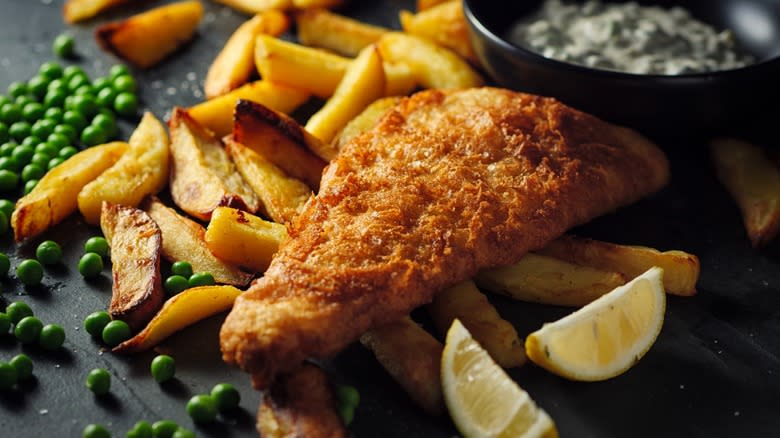
Before everyone reading this riots at the thought of eschewing fish and chips in an Irish pub, hear us out. Fish and chips are undoubtedly quintessential Irish and British food, and we're not saying that you should turn your nose up at this frankly delicious offering. But we do have a few words of caution for those of you looking for the best dinner possible.
While fish and chips might be one of the best Irish pub foods you could try, you still need to take care when ordering, because an Irish-style pub isn't the same as a local Irish or U.K. chippy, where this dish is probably at its best. There are a couple of things to look out for when perusing the menu and deciding what you want. Fresh fish is better than frozen, but even good-quality frozen filets will do if you're in a locale far from the coastline. It won't matter, though, if your dinner has been battered before it even arrives in the restaurant's kitchen. Instead, the tastiest fish should be dipped right before frying and dropped into a light batter, made with a dark stout, a lighter ale, or even with carbonated water added to the mix, for an airy coating with plenty of crispness.
Irish Nachos
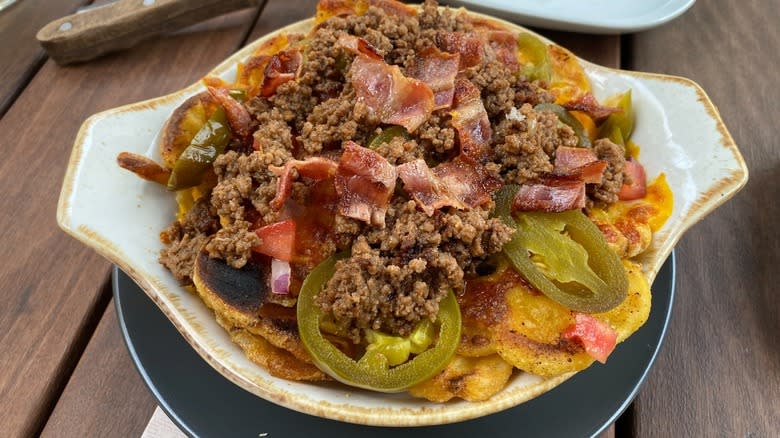
Here's another non-Irish, yet still kind-of-Irish menu item: nachos made with potatoes. Again, like all the other adulterated menu items on this list, we get the appeal. Potatoes? Cheese? Sour cream? Jalapeños? Count us in. But if you're looking for an authentic Irish taste, this isn't going to be it, no matter how many leeks or cabbages you use. This is especially true if you're looking for something spicier; we don't know about you, but Ireland isn't on the top of our fieriest foods list.
Like the crisp sandwich or the Dublin coddle, this might be something you can whip up at home to quell that craving. Lucky for you, we even have a recipe for our own version of Irish nachos; and let's be honest, they're absolutely fantastic (even without leeks or cabbage). But the point that we're trying to drive home is that no matter how much we love fusion food, when you get the chance to try traditional Irish food, you should take it. So if you get the opportunity to visit Ireland -- one of the friendliest, greenest, and most buttery places on Earth (that's this writer's DNA speaking) -- or to enjoy even an Americanized version of Irish food, eat like a local. Not your thing? Then go ahead and order those potato nachos — they still sound delish.
Potato Bread
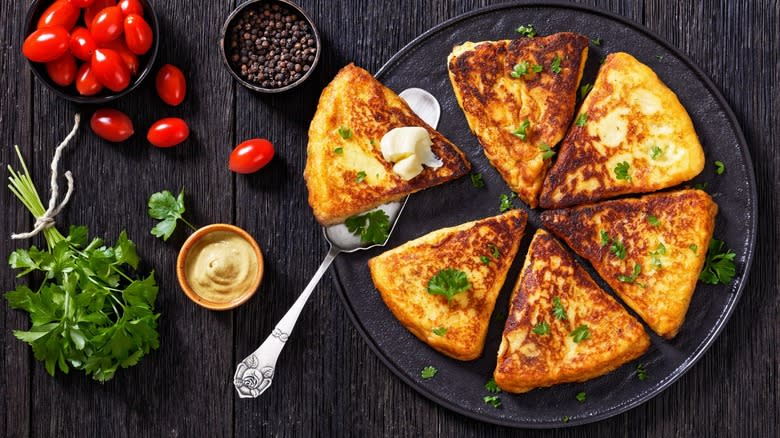
Like almost everything else on this list, we're not trying to talk you out of eating any particular Irish food. Instead, we're just pointing out some of the better choices for a night on the town, Éire-style. If you've ever tried potato bread, then you know we'd be crazy to tell you not to eat it.
Known as farls in Ireland, this carby side is pure heaven. We know there is nothing like fresh, warm bread smothered in butter. Now imagine that the bread is made with mashed potatoes and lightly fried before getting to your table. Yeah, definitely irresistible. Depending on the recipe, farls can range from something akin to a crisp potato pancake or, with the addition of more flour, almost like a heavy scone. Either way, that's still a lot of potatoes to chomp through before dinner even gets to you — and like any other bread offering in a restaurant, it's just going to fill you up before the main course arrives.
You can instead opt for Irish soda bread if you don't want to miss the bread course. Irish soda bread is different from the American version, the latter of which includes the addition of raisins and caraway — two things you won't get in a traditional loaf. No matter where it comes from, cross your fingers that not only have the bakers sliced a fairy-dispelling cross (they're awfully troublesome, we hear!) on the top of the loaf, but that it also comes with a large side of delicious Irish butter.
Seafood Chowder
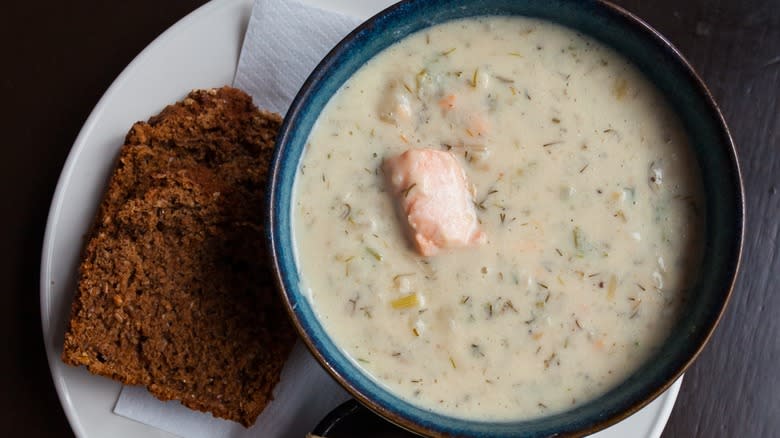
When you're looking for the best seafood, island nations or coastal communities are your best bet, from Japan to Chile to Newfoundland. And so, much of Ireland (and the U.K.) is known for fish dishes, but not all of it. What we are saying is that, depending on the location of your Irish-style restaurant, you might want to rethink your order. Think about the size of Ireland and the U.K. in comparison to North America and consider: How close is your local pub to the sea, and how important is it that your seafood order is that day's catch?
It might not be that important to you, and let's face it, a lot of frozen seafood is pretty good. But unless the restaurant is sourcing fresh, local fish, you might find that the chowder is, well... a little lackluster. Now, perhaps your local pub really does have a catch of the day, which could make the seafood chowder a terrific dinner option. If not, you might be looking at a bowl of premade and reheated soup with less-than-fresh fish tossed in.
Like real estate agents say, it all depends on location. So if you're desperately craving a creamy soup at your favorite Irish pub, perhaps consider trying something with a potato base, instead.
Static Media owns and operates Tasting Table and Mashed.
Read the original article on Tasting Table.

